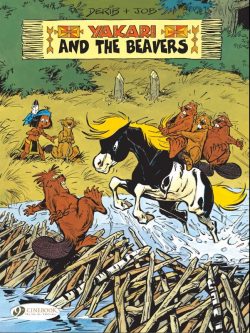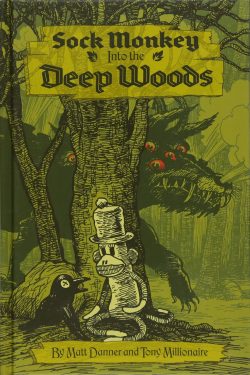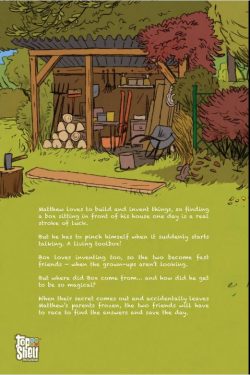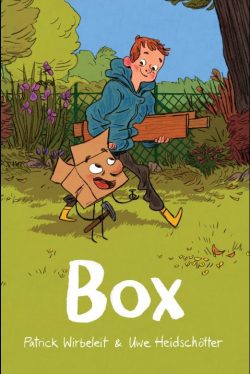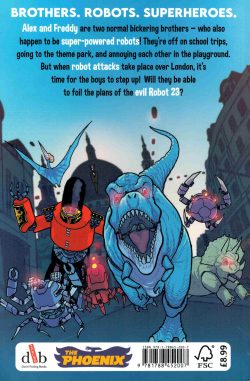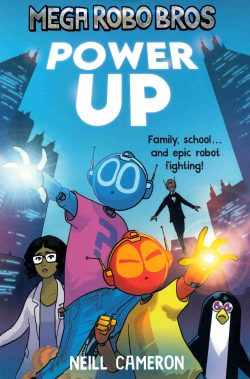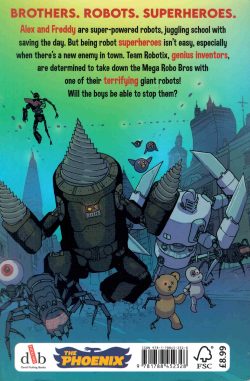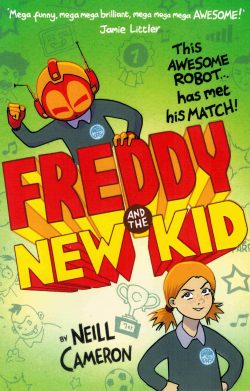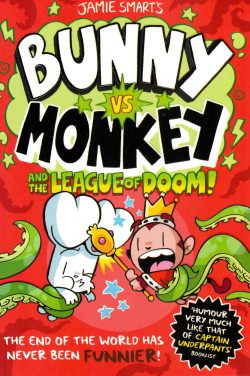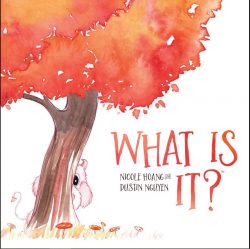



By Osamu Tezuka, translated by Frederik L. Schodt (Dark Horse Manga)
ISBN: 978-1-56971-681-6 (TPB 6) 978-1-56971-790-5 (TPB 7)
There’s nothing like the real thing. After a range of robotic rapscallions and kid-friendly constructions, here’s a double dose of the original and genuine mechanical marvel of any age…
From beginning his professional career in the late 1940s until his death in 1989, Osamu Tezuka generated an incomprehensible volume of quality work which transformed the world of manga and how it was perceived in his own country and, ultimately, across the globe. Devoted to Walt Disney’s creations, he performed similar sterling service with Japan’s fledgling animation industry.
The earliest stories were intended for children but right from the start Tezuka’s expansive fairy tale stylisations harboured more mature themes and held hidden pleasures for older readers and the legion of fans growing up with his manga masterpieces…
“God of Comics†was born in Osaka Prefecture on November 3rd 1928, and as a child suffered from a severe illness. The doctor who cured him inspired the lad to study medicine, and although Osamu began drawing professionally whilst at university in 1946, he persevered with college and qualified as a medical practitioner too. Then, as he faced a career crossroads, his mother advised him to do the thing which made him happiest.
He never practiced as a healer but the world was gifted with such masterpieces as Kimba the White Lion, Buddha, Black Jack and so many other graphic narratives.
Working ceaselessly over decades, Tezuka and his creations inevitably matured, but he was always able to speak to the hearts and minds of young and old equally. His creations ranged from the childishly charming to the distinctly disturbing such as The Book of Human Insects.
Tezuka died on February 9th 1989, having produced more than 150,000 pages of timeless comics; created the Japanese anime industry and popularised a uniquely Japanese graphic narrative style which became a fixture of global culture.
These monochrome digest volumes (173 x 113 mm in the physical world and any size you like if you get the eBook edition) continue to present – in non-linear order – early exploits of his signature character, with the emphasis firmly on fantastic fun and family entertainment…
Tetsuwan Atomu (literally “Mighty Atom†but known universally as Astro Boy due to its dissemination around the world as an animated TV cartoon and one of post-war Japan’s better exports) is a spectacular, riotous, rollicking sci fi action-adventure starring a young boy who also happens to be one of the mightiest robots on Earth.
The series began in 1952 in ShÅnen Kobunsha and ran until March 12th 1968 – although Tezuka often returned to add to the canon in later years, both in comics but in also in other media such as the newspaper strips reprinted and repackaged here. Over that period, Astro Boy spawned the aforementioned global TV cartoon boom, starred in comic book specials and featured in games, toys, collectibles, movies and the undying devotion of generations of ardent fans.
Tezuka frequently drew himself into his tales as a commentator, and in his later revisions and introductions often mentioned how he found the restrictions of ShÅnen comics stifling; specifically, having to periodically pause a plot to placate the demands of his audience by providing a blockbusting fight every episode. That’s his prerogative: most of us avid aficionados have no complaints…
Tezuka and his production team were never as wedded to close continuity as fans are. They constantly revised both stories and artwork in later collections, so if you’re a purist you are just plain out of luck. Such tweaking and modifying is the reason this series of collections seem to skip up and down the publishing chronology. The intent is to entertain at all times so stories aren’t treated as gospel and order is not immutable or inviolate.
It’s just comics, guys…
And in case you came in late, here’s a little background to set you up…
In a world where robots are ubiquitous and have won (limited) human rights, brilliant Dr. Tenma lost his son Tobio in a traffic accident. Grief-stricken, the tormented genius used his position as head of Japan’s Ministry of Science to build a replacement. The android his team created was one of the most groundbreaking constructs in history, and for a while Tenma was content.
However, as his mind re-stabilised, Tenma realised the unchanging humanoid was not Tobio and, with cruel clarity, summarily rejected the replacement. Ultimately, the savant removed the insult to his real boy by selling the robot to a shady dealer…
One day, independent researcher Professor Ochanomizu was in the audience at a robot circus and realised diminutive performer “Astro†was unlike the other acts – or indeed, any artificial being he had ever encountered. Convincing the circus owners to part with the little robot, the Prof closely studied the unique creation and realised just what a miracle had come into his hands…
Part of Ochanomizu’s socialization process for Astro included placing him in a family environment and having him attend school just like a real boy. As well as providing friends and admirers the familiar environment turned up another foil and occasional assistant in the bellicose form of Elementary School teacher Higeoyaji (AKA Mr. Mustachio)…
The wiry wonder’s astonishing exploits resume after the now traditional ‘A Note to Readers’ – explaining why one thing that hasn’t been altered is the depictions of various racial types in the stories.
The author was also keen on combining all aspects of his creation into one overarching continuity. This volume opens with ‘“Once Upon a Time†Astro Boy Tales Part 1′ January 24th – December 23rd 1967: reprinting modified strips from the serial that ran in the Sankei newspaper. In his cartoon persona, the God of Comics explains how the cliffhanger ending of the TV series (falling into the sun on a malfunctioning nuclear fusion blocker) never sat well with him.
Filling in gaps, Tezuka here reveals how the depowered robot boy was originally rescued and repaired by insectoid aliens and restored to Earth, but also how he has since rejected that plot twist and replaced it with a new one in ‘Beginning of the Contradiction’…
Now, while enjoying an evening flight over his beloved city, Astro is caught in the explosion of a crashing spaceship. He also saves a locust woman passenger who has taken more-or-less human form. After sharing her tale convoluted tale of romantic woe – involving two males determined to fight to the death for her – Scara Ohara realizes she is marooned on Earth, but that’s not the biggest problem she and her robot rescuer face. When Astro goes for help, he discovers the detonation has cracked the time barrier, plunging them back 50 years to March 1969…
While scouting ancient (by his lights) Tokyo and reeling in shock, Astro meets and befriends a little boy. He soon learns that there are no other true robots in existence and that little Shin-Chan is the world’s greatest beggar.
The diligent mendicant offers the stranded strangers accommodation in his plush house and is astounded when Astro reveals his artificial nature and great dilemma. The mechanoid needs constant atomic fuel top-ups or he will cease to function, but now – decades away from sustenance – is living on borrowed time…
‘Living on Earth 101’ finds Shin-Chan urgently schooling the strangers on the primitive, intolerant world they now live in: building a home, getting jobs as Astro deduces that – if he’s careful – he can live three more years. There are numerous embarrassing and simply dangerous moments where their secret is almost exposed, such as the time he digs up rare gems from inside a volcano but cannot explain how he got them to extremely curious diamond sellers…
Scara cannot understand the concept of work, but easily adapts to the joys of shopping, and lure of “fun†with a succession of attentive men, piling pressure on the sensible robot and triggering an encounter with ruthless thieves and the first of Astro’s contacts with people he will know half a century from “nowâ€.
It’s the birth of the age of automation and Astro regularly meets prototype constructs that painfully remind him of home, where robots are sentient and have equal rights. Here, his kind are considered, silly fantasy, toys and potential job-stealers. Pioneering scientists often work in secret, such as the masked dabbler building his metal men in a secret underground lair.
‘The Birth of Neva #2′ sees a painfully young Ochanomizu take on the human-seeming weird kid Astro as an assistant… with startling repercussions.
As Scara continues to flounder in a strange world, ‘Baro, the Robot’ finds her at odds with her rescuer after she reveals that on her world, all mechanoids are slaves. Incensed, Astro rockets away, wasting precious energy to ostensibly investigate the rogue nation of Peakok, which has shocked the world with twin announcements: it is now a nuclear power, and its H-bombs are deployed by a robot delivery system…
As Astro enters the sinister police state, President Bundell is already taking charge of scientist Carpon‘s beloved brainchild Baro. The dictator has no idea that the sentient machine has the mind and personality of a human toddler, whilst the nuclear weapon really hates the idea of killing or dying: opinions fortified after meeting and debating with Astro. That all tragically changes when the President murders rebellious Carpon and Baro seeks revenge…
Squandering power, Astro only has six months energy remaining when the next crisis occurs. ‘Scara Disappears’, reveals how the emotionally dislocated alien – growing evermore discontented – flees to the mountains to escape humanity. When the boy bot returns, guilt drives him to investigate Mount Tanigawa, eventually finding Scara has changed shape and joined the bugs living there. With time running out, he and Shin-Chan make contingency plans: a scheme to store Astro’s power-depleted form for the decades necessary to catch up with the technology needed to sustain him, when the moment of total depletion finally comes…
In the meantime, Astro works with young Ochanomizu on developing robots. Faced with constant failure and the fact that society hates and does not want truly autonomous mechanoids, the boffin is despondent and Astro considers sharing his astonishing secret. Suddenly disaster strikes when a building collapses, and the heroic droid sacrifices most of his dwindling reserves to save people trapped in the wreckage. To keep his secret, Astro wears an old robot shell, but the act provokes a crisis as the authorities want the saviour machine that Ochanomizu knows could not have even moved, let alone independently rescued the victims. Revealing his true nature to the Professor, Astro accidentally sparks a national manhunt before falling into the hands of spies with only three days power remaining.
These monstrous thugs have their eyes on another nation’s top-secret technology.
‘The Energy Tube’ could preserve Astro’s existence so he reluctantly agrees to join them and is soon being smuggled out of Japan in a submarine…
This volume ends on a chilling cliffhanger as Astro’s conscience overrides his survival instincts. Refusing to be anybody’s secret weapon, he scuppers the sub and escapes, only to fly into a massacre: US jets bombing peasants. The war in Southeast Asia was in full swing when Osamu Tezuka crafted these stridently anti-war episodes which depicts the Mighty Atom routing American ground and air forces with his last vestiges of energy. When he collapses and is reverently interred, his “corpse†is disturbed and sinks into the Mekong river when the revenge-hungry Americans return to obliterate the village that even ‘The Angel of Viet Nam’ could not save…
To Be Continued…
Osamu Tezuka’s Original Astro Boy Volume 7 offers the same standard preliminaries and The Story Thus Far’ before resuming the Sankei newspaper adventure ‘“Once Upon a Time†with Astro Boy Tales Part 2′ (spanning December 24th1967 to September 27th 1968). Returning to prognostication, the master jumps to ‘The Summer of 1993’ and a world largely at peace and thriving on scientific progress. A dredger in the Mekong plucks a strange doll out of the mud, and – thanks to a handy note attached by Astro Boy – is returned to a certain person in Tokyo.
Little beggar Shin-Chan is now prestigious, powerful businessman Shingo Yamanaka, but he has never forgotten his childhood companion and despite his subordinates suspicious quibbling, spends a fortune on a new energy tube system to repower the inert doll. Marginally successful, the magnate introduces Astro to a world far closer to, but still not his own.
He and his flighty daughter Surume are the only ones who know his secret, and share his woe that although robots are now commonplace, they are still deliberately limited: a worker underclass who “know their place†and always end up on scrap heaps…
With only one day of full power, Astro knows this is not a situation he can fix. Dutiful and loyal, his first action is to check on Scara, who has been with the locusts on Mount Tanigawa for a quarter of a century now. Unsuccessful in this task, he allows Surume to show him the sights, especially the colossal Fun-Zone where humans go to release tensions, Dancing, playing or acting out their frustrated desires to kill in robot-staffed theme parks. Thy have to be careful though, unsupervised robots are illegal and subject to instant destruction if caught in human zones…
Professor Ochanomizu has not been idle. He still seeks to perfect sentient robot creation and his latest success is his pride and joy. However, its advanced nature makes the construct a perfect patsy when criminals frame it for a bold robbery. ‘Robot Chiruchiru in Danger’ finds the nobly stoic automaton on trial for its life. Surume and Astro strive mightily and heroically to save it, but tragedy strikes when the thieves outsmart the robot boy and justice takes a cruelly biased turn…
After turning the tables on the crooks ‘Astro’s Energy Runs Out’ and his day in the sun ends with him again shutting down, this time in the meadow where he had last seen Scara…
More time passes and the story almost comes full circle, as the origins of Astro Boy revisited in ‘Dr. Tenma’ with the tragedy of the deranged genius and his son Tobio expanded to reveal how parental neglect, overwork and compensating guilt all contributed to the construction of the dead boy’s synthetic substitute, and what the obsession to build him actually cost…
A further unknown complication is simultaneously beginning on Mount Tanigawa, where hibernating Scara awakes beside the eroded body of Astro Boy and realises a long-anticipated time-loop paradox is about to occur with two versions of the same person now occupying the same timeline. The solution is horrible, inevitable and ultimately miraculous…
‘The Tragedy of Bailey’ focuses on the robot boy’s painful failure to fit into the Tenma household: his mother’s anxiety and father’s spiralling into madness, and reappearance of aged Professor Ochanomizu, with constantly-baffled “Tobio†stumbling from crisis to crisis before being summarily handed over to a businessman whose behind the scenes dealings had enabled Tenma to complete his resurrection project…
This embroils him in a bizarre doomed plot to force America to recognize robot rights, but end horrifically for pioneering freedom fighter Bailey…
Returned to Japan, Tobio’s relationship with Tenma further deteriorates and ‘Astro Goes to the Circus’ sees time turn a full circle as the Science Minister wearies of the farce and sells his robot boy to inspirationally sadistic circus impresario Hamegg who renames his goldmine star attraction Astro Boy…
Subjected to an escalating round of gladiatorial combats and life-threatening stunts, Astro rebels and runs away, but even personal tragedy and the wiles of Ochanomizu are enough to keep the mighty mech out of Hamegg’s brutal clutches and despite showing his valiant mettle, this tome concludes on another cliffhanger with Astro Boy a battered slave of the worst that humanity can produce…
To Be Continued…
Breathtaking pace, outrageous invention, slapstick comedy, heart-wrenching sentiment and frenetic action are hallmarks of these captivating comics constructions: perfect examples of Tezuka’s uncanny storytelling gifts, which can still deliver a potent punch and instil wide-eyed wonder on a variety of intellectual levels. The melange of marvels is further enhanced here by an older, more sophisticated tone and the introduction of political and social commentary, proving Astro Boy to be a genuine delight for all ages.
Tetsuwan Atom by Osama Tezuka © 2002 by Tezuka Productions. All rights reserved. Astro Boy is a registered trademark of Tezuka Productions Co., Ltd., Tokyo Japan. Unedited translation © 2002 Frederik L. Schodt.




